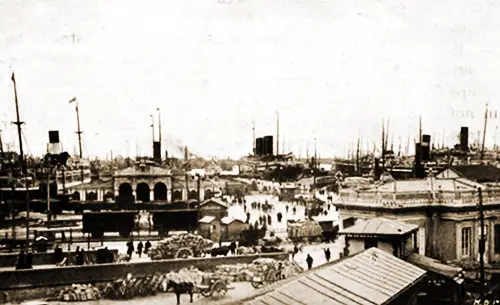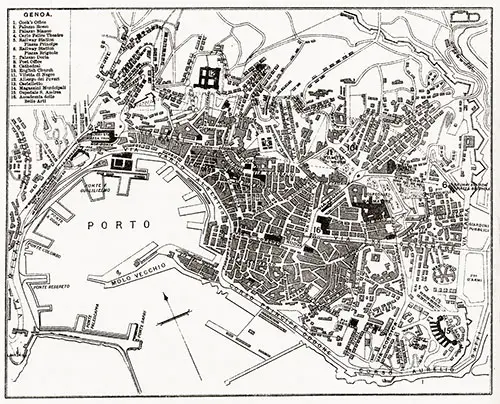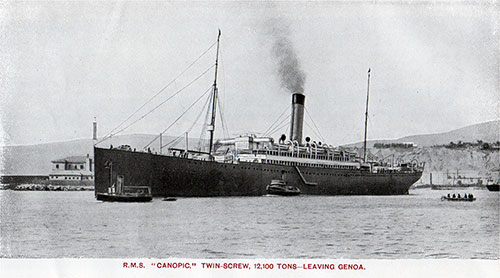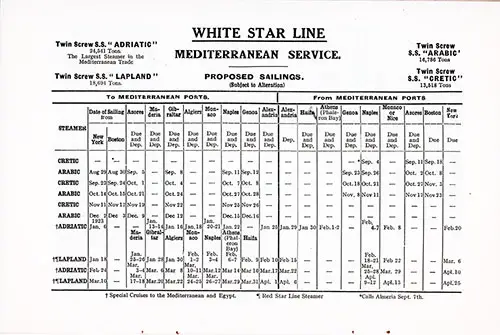Port of Genoa, Italy

The Port of Genoa, Italy circa 1907. GGA Image ID # 143f6c8b42
Approach to Genoa (1911)
The approach to Genoa, from either Naples or the western Mediterranean, is in sight of noble shores. Arriving from the West the course is along the French Riviera, with the bold cliffs and famous cities and the Maritime Alps in full sight.
Coming up from Naples there are grand coast views the whole distance as the vessel passes the shores of Campania Rome, Umbria and Tuscany with the mountain ranges of the Apennines for a background. The great Gulf of Genoa is entered from the South as Spezzia is seen at the head of a gulf of the same name.

Map of the Port of Genoa, Italy. Cunard Line Handbook, 1905. GGA Image ID # 1fbdd89af6
The mountains crowd close to the coast for the fifty miles beyond of the Riviera di Levante. On the narrow seaboard, there is almost a continuous string of towns more and more closely connected as Genoa is neared. The watering place of Sestri Levante seen where the mountains have withdrawn a little from the shore,
Rapello in a corner formed by the promontory of Portofino, and Nervi near Genoa, are important winter and summer resorts. The green Apennines with their lower slopes sprinkled with villas, fill in the last few miles before the city is reached.
Two huge moles shut in the semicircular harbor of the city, the Molo Nuova on the left overlapping the Molo Vecchio on the right. Genoa in its mountain amphitheater about a deep notch in the bay coast lies on the right of the course into the docks. The naval dockyard and arsenal are straight ahead.
A chain of forts on the heights above runs about the town and port. The highest is Fort della Sperone. The city climbs from terrace to terrace, its churches, campanile and palaces making a superb sight. At the ends of the moles are lighthouses, and at the west where the city line ends at a headland, is the lighthouse of the famous view embracing the snow-capped mountains, the sea, both Rivieras, and the town and harbor. Beyond the lighthouse to the left is a continuous line of towns running from Pierre d’Arena, the nearest suburb on by Pegli as far as the eye can reach.
On Watch - The Port of Genoa (1903)

RMS Canopic, Twin-Screw, 12,000 Tons, Shown Leaving the Port of Genoa, Italy. GGA Image ID # 144de62858
Like many a well-known city that has survived the flight of time, the renowned city of Genoa -- Genova La Superba—has found it necessary to put her house in order, lest other more up-to-date places entice trade away from her.
Moreover, the railway engineer, and the recent alterations in the law, have, apparently, ensured for the larger ports of Italy a flowing tide of activity from a commercial point of view.
In 1891, the tonnage arriving at Genoa totaled up to 3,334,284 tons, and a decade later it had increased to 5,017,736 tons; while during the same period the average size of the ships had increased at least 40 percent. More tonnage and bigger ships are the usual attendants of modern methods at a port, and, unless Genoa is prepared to make matters easier for the loading and unloading of ships, she need not be surprised if some of her lusty young rivals succeed in capturing part of the trade which would otherwise have gone to her almost automatically.
Captain Salvatore Raineri has brought forward a scheme for protecting the port of Genoa from the rude attacks of Æolus and Neptune, so that ships may the more readily enter there; discharge such cargo as they have; and get away without any more risk or delay than if the work were done inside the most commodious and sheltered dock of London or Liverpool.
The Law of Storms is known to every seaman since the day when the American inquirer into this highly important matter—Redfield, of New York —indicated that storms of the Northern Hemisphere moved bodily onward as a huge whirl, the winds of which were at the same time revolving around a calm central area in the direction of the hands of a watch.
Redfield did not believe the shape of the travelling whirl was always purely circular, and now it is admitted that the winds have an indraft towards the storm center.
Captain Raineri has evidently devoted considerable attention to the weather charts of Italy, and thus obtained an accurate idea of the average trajectory of storms, with respect to Genova La Superba.
We fail to remember a single instance where the theory of the Law of Storms has been put so admirably into practical application as in the system suggested by Captain Raineri.
Knowing the average storm track, and familiar with the cyclonic theory, he has suggested a plan of quadruple breakwaters, which are so arranged at the mouth of the port as to provide the greatest facility for the ingress and egress of shipping, while at the same time preventing the heavy swells caused by the winds of the cyclonic storms from making themselves uncomfortably felt among the shipping inside.
The Rivista Nautica, of Turin, for February last, contains a short summary of a paper on this subject, read by Captain Raineri at the Institution of Civil Engineers and Architects, Genoa; and the Annalen der Hydrographie und Maritimen Meteoroligie has a very favorable review of Captain Raineri's proposed quadruple breakwaters for Genoa, from the pens of Dr. Herrman, a meteorologist of repute, and Captain Wislicenus, of the Imperial German Navy.
In both cases the diagrams are clear and precise. The first breakwater of the four suggested commences at a distance of 1,524 ft. east-south-east of the Galliera Mole, and trends east-north-east about 1,000 ft.; and the other three breakwaters are arranged at equal-distant intervals along a lune-shaped area having its furthest point about 500 ft. from the center of the Grand Mole.
An entrance of over 1,500 ft. will serve for the leviathan liners, and smaller vessels can get in on the other side of the breakwaters. Shipmasters visiting Genoa will do valuable service to their cloth, and to the shipping industry at large, if they will carefully study this unique system of quadruple breakwaters, based upon the cyclonic theory, which has been so scientifically thought out by Captain Salvatore Raineri.
Sailing Schedules
White Star Line Mediterranean Service Proposed Sailings from 29 August 1922 to 13 April 1923. Ships Included the Adriatic, Arabic, Cretic, and Lapland. Ports Included New York, Boston, Azores, Madeira, Gibraltar, Algiers, Monaco, Naples, Genoa, Alexandria, Haifa, Athens (Phaleron Bay), and Nice. RMS Majestic Passenger List, 6 September 1922. GGA Image ID # 1dd525881f. Click to View Larger Image.
Bibliography
Presbrey, Frank, "Approach to Genoa," in Presbrey's Information Guide for Transatlantic Travelers, Seventh Edition, New York: Frank Presbrey Co., 1911: P. 49-50.
"On Watch – The Port of Genoa," in The Syren and Shipping: A Weekly Illustrated Journal, Vol. XXVII, No. 341, Wednesday, 11 March 1903, p. 52.

